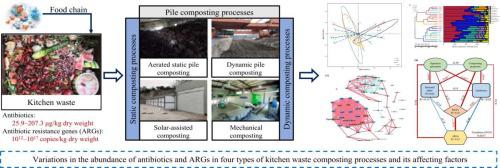Journal of Hazardous Materials ( IF 12.2 ) Pub Date : 2021-10-19 , DOI: 10.1016/j.jhazmat.2021.127526 Changxun Zhao 1 , Liqing Xin 1 , Xingkun Xu 1 , Yong Qin 1 , Weixiang Wu 1

|
Kitchen waste might be a potential source of antibiotics and antibiotic resistance genes. Composting is recognized as an effective way for kitchen waste disposal. However, the effects of different kitchen waste composting types on the removal of antibiotics and antibiotic resistance genes haven’t been systematically studied. In this study, the dynamics of antibiotics and antibiotic resistance genes from kitchen waste of four composting processes were compared. Results showed that although kitchen waste was composted, it remained an underestimated source of antibiotics (25.9–207.3 μg/kg dry weight) and antibiotic resistance genes (1012–1017 copies/kg dry weight). Dynamic composting processes (i.e., dynamic pile composting and mechanical composting) decreased the antibiotic removal efficiency and increased the abundance of some antibiotic resistance genes (5.35–8534.7% enrichment). Partial least-squares path model analysis showed that mobile genetic elements played a dominant role in driving antibiotic resistance genes dynamics. Furthermore, redundancy analysis revealed that temperature, pH, and water content considerably affected the removal of antibiotics and mobile genetic elements. This study provides further insights into exploring the effective strategies in minimizing the risk of antibiotic resistance from kitchen waste via composting process.
中文翻译:

四种餐厨垃圾堆肥过程中抗生素和抗生素耐药基因的动态
厨余垃圾可能是抗生素和抗生素耐药基因的潜在来源。堆肥被认为是处理厨余垃圾的有效方式。然而,不同厨余堆肥类型对抗生素和抗生素耐药基因去除的影响尚未得到系统研究。在这项研究中,比较了四种堆肥过程的厨余垃圾中抗生素和抗生素耐药基因的动态。结果表明,尽管厨余垃圾被堆肥,但它仍然是被低估的抗生素(25.9–207.3 μg/kg 干重)和抗生素抗性基因(10 12 –10 17份/公斤干重)。动态堆肥过程(即动态堆肥和机械堆肥)降低了抗生素去除效率并增加了一些抗生素抗性基因的丰度(5.35-8534.7%富集)。偏最小二乘路径模型分析表明,移动遗传元件在驱动抗生素抗性基因动态中起主导作用。此外,冗余分析表明,温度、pH 和水含量对抗生素和移动遗传元素的去除有很大影响。本研究为探索通过堆肥过程最大程度降低厨余产生抗生素耐药性风险的有效策略提供了进一步的见解。











































 京公网安备 11010802027423号
京公网安备 11010802027423号